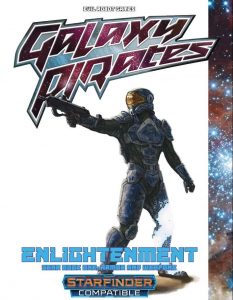Galaxy Pirates Gear Book One: Enlightenment (PFRPG/SFRPG)
Galaxy Pirates Gear Book One: Enlightenment (PFRPG/SFRPG)

This supplement comes with two 12-page pdfs. In these, we have 1 page front cover, 1 page editorial/ToC. In the PF-version, we have two pages of SRD, in the SF-version, just one, though that version does have half a blank page in the end. We thus clock in at 8 pages of content for PFRPG, 8.5 for SFRPG, so let’s take a look!
Both versions assume credits, unsurprisingly for a scifi supplement – but prices etc. have been adjusted individually. We begin both versions with a collection of 8 different types of armor/space suits.
In the pathfinder iteration, the table lists separate bonuses for non-proficiency with the armors, and one of the suits actually integrates into a flight suit, while another basically represents a massive powered armor-like piece that feels akin to the relatively obscure Gallowglass’ ultra-heavy armor from 3.X days of yore, with a weight of no less than 400 lbs. and a massive -7 armor (in PF) check penalty. Some of these suits have integrated life-support canisters and note as such, while the latter ultra-heavy armor notes that it has thrusters that allow for reliable short-distance (30 ft.) jumps, which succeed automatically. In SF, that is instead a 30 ft. flight speed – I assume, a supernatural one for functionality in vacuum, though the pdf does not explicitly state this.
A complaint that can be fielded against the Pathfinder version, but not against the Starfinder equivalent, would be that the table does not differentiate between armor class – light, medium and heavy. Indeed, the Starfinder table, to me, seems to be more refined, clearly categorizing aforementioned ultra-heavy Katar armors as powered armors, skin suits as light, etc. Appropriate item levels have been included for your convenience in the SF iteration. The pricing here has been carefully deliberated upon – jump suit + helmet represents, for example a cross between stationwear and estex suit, without the latter’s beneficial additional tricks. Still, it fills a nice niche in the lowest price-segment. On the less fortunate side of things, while the heavier Katar armors have been properly codified as powered armor, they do lack the appropriate capacity and usage values for their item class, and they also, alas, lack the damage value for attacks executed with them, making them, as presented, alas, not 100% functional.
The eldred skin suit variant is arguably close to the default skin suit by necessity and design space available, but here would be a good place to note a peculiarity of this supplement that is very much worth mentioning: Instead of just handing you a brief throwaway description, the respective item-classes do get a pretty detailed description in how they interact, can be upgraded, or pertaining their peculiarities. Eldred skin suits not specifically fitted for the respective person, for example, impose a nasty additional armor check penalty on the wearer. In these descriptions, though, something that works fine in the Pathfinder iteration…doesn’t work in SF. You see, human armor’s forte, if you will, is that the cushioning blue goo makes repair much easier – in Pathfinder, this is correctly codified with an equipment bonus and rules for easier use of Craft in conjunction with repairing these suits. In Starfinder, this section has, alas, unfortunately been retained, and as we all know, there is no Craft skill in Starfinder, nor are there equipment bonuses – in this case, that should probably be enhancement bonuses and a reference to Engineering’s capability of repairing tech items. This issue, alas, also extends to the human-manufactured Eldred Ferox guns later in the pdf, and in the Pathfinder-version, the bonus here is not properly codified. Ironically, the lack of mentioning a skill and bonus type means that in this instance, the Starfinder version is actually better.
The pdf also contains 7 analog guns spanning, in SF, item levels 1 – 15. Unpleasant oversight in the Starfinder-version: The table, alas, does not classify the weapons by type. The katar gyrojet rifle, for example, is most assuredly a heavy weapon, and one can assume pistols to be small arms, rifles to be longarms. This is particularly odd, since the descriptive text does note proper weapon categories – so yeah, it’s more of a cosmetic issue than anything else, but it is still a somewhat jarring one. All of them seem to be projectile weapons, so no complaints in that regard. As for the Pathfinder iteration, the weapons table properly codifies them with automatic/semi-automatic properties, and now also features them noting when they’re light, 2-handed, etc. As a minor complaint, the table does have a footnote to explain semi-automatic and automatic fire, which, while appreciated, does not encapsulate the entirety of the respective firing effects. A sidebar that provides the entirety of the rules, which btw. are fashioned after the Technology Guide, would have been appropriate here to avoid confusion.
Another thing bears mentioning, one aspect that may irk those among you who are keen on proper formatting conventions: In both versions, the names of mundane armors have been italicized and are capitalized in the flavor text. While this makes them easily discernible in the text-flow, it does contradict formatting conventions for both systems. On the plus-side, the descriptive text does an excellent job in properly describing how these items actually work – it may be a small thing for some, but personally, I really enjoyed how this made them come alive for me.
The second half of the pdf is devoted to enhancements – basically special weapon or armor properties (in PF) or weapon fusions/armor upgrades in SFRPG. However, in contrast to most supplements that present the like, we have a distinct table here that deviates from what you’d expect to find. Galaxy Pirates assumes that these enhancements actually are often mutually exclusive, which presents an interesting angle. Sure, you can get that sniping enhancement, but if you do, you won’t have active camouflage. This is a really interesting balancing tool, but it also limits the direct usability of these, at least until a big Galaxy Pirates item book has hit sites. Why? Because neither Pathfinder nor Starfinder supplements from other publishers do note such incompatibilities, which can make interaction somewhat challenging on the GM. Some guidelines for determining incompatibilities would vastly enhance the usefulness of this section.
Another aspect that is not entirely necessary for either system would be the battery/power cell rules presented, as they note explicitly two charge arrays (20 and 40), when e.g. Starfinder knows batteries with more charges. More severely, the pdf classifies two types of fusion, namely visual and energy fusions, which, while an apt differentiation, also notes that energy enhancements draw a total of 20 uses from a battery before depleting it – it is clear that this does not mean that one use costs 20 charges, but considering how batteries can have more than 20 charges, it’s still a direct contradiction to the main system rules AND the pdf’s internal text. Usage is RAW supposed to be part of the write-ups of the respective fusions, but the majority of them do not feature any notes, even when shields make it clear that there probably should be some sort of note there. Considering how thus the base engine leaves me with quite a few questions for these, I have a hard time judging them for their viability in Starfinder, which is a pity, as I per se enjoyed that, to name a few, the elemental resistance-themed armor upgrades actually differ from one another and don’t simply copy one another. Similarly, the writing for the respective fusions and upgrades is actually pretty consistent as a whole, and e.g. thankfully refrains from including crit-fishing options. On the downside, we do have references to obsolete bonus types (which also are formatted wrong – bonuses are not capitalized). A big plus: The latest iteration of this pdf got rid of a nasty keen-stacking bug, though the 2000 credit price is still pretty low. Nonetheless: Kudos for fixing this one!
While in Starfinder, the issues here present from obvious conversion hiccups, in pathfinder, they hail from assuming a set of setting realities that the reader is only partially privy to – in either iteration, the book could use a bit of further refinement, and I’m optimistic it’ll get that, as Evil Robot Games has been really good regarding the care and updating of their products.
Conclusion:
Editing on a formal level, is very good, but the extent of the deviations from formatting conventions in both systems is somewhat jarring. On a rules-language level, the pdf has a couple of issues that hurt me more than I expected them to – because this gets it *almost* right in all instances, only to falter in the details. The latest update has already improved the pdf significantly in multiple cases. Layout adheres to a printer-friendly two-column standard with colored highlights and a surprisingly cool array of gorgeous full-color artworks. In Starfinder, we get a small, star-covered border, which is a nice touch. This is an aesthetically-pleasing pdf – slightly more so in the SF iteration. In both versions, we do not get any bookmarks. At this length, that’s barely okay, but not a reason to per se penalize the pdf.
The more I read of the Galaxy Pirates setting, the more intrigued I am – the attention to detail and emphasis on immersion enhancing strategies is something right up my alley, and indeed, it can be found here as well. Paul Fields and Jim Milligan tackle several complex concepts in this supplement, and I was surprised to note how the descriptions enabled me to picture the respective items and how they actually work. I hope this tendency will continue. That being said, this is also one of the earliest Galaxy Pirates supplements, and it shows. The rules, alas, contain an array of small issues in the details that accumulate over the course of this supplement. Much to my chagrin, quite a few of these do impede the direct functionality of the content within – and this, in different ways, holds true for the respective versions for both systems. While there have been improvements made, the pdfs still remain rather rough around the edges. As such, my final verdict cannot exceed 2.5 stars, rounded up due to in dubio pro reo and due to being a freshman offering.
You can get this pdf here on OBS.

Endeitgeist out.
